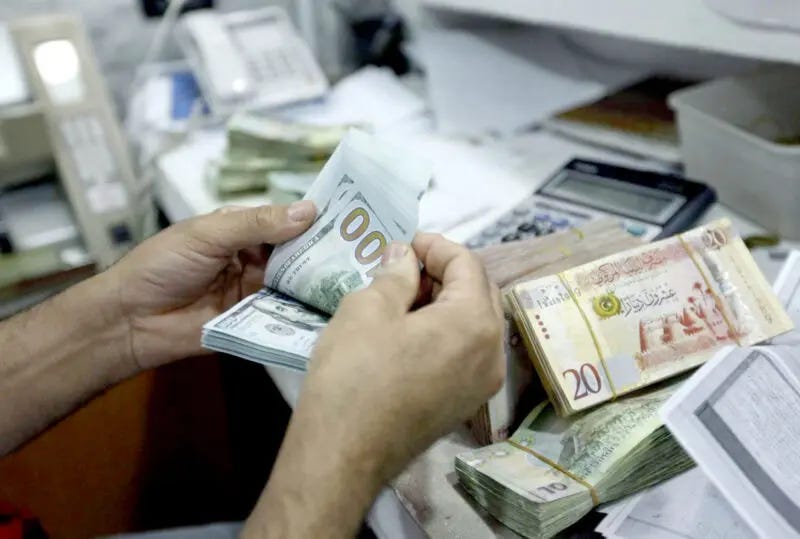Libyan Issuance of New Banknotes Aims to Attract Foreign Investment
The decision to print new currency in 2025 is likely part of Libya’s broader strategy to stabilise its financial market and currency exchange rate to attract foreign investments.
On Sunday, the Central Bank of Libya (CBL) announced the printing of new banknotes to be distributed in 2025. Thirty billion Libyan dinars, approximately equivalent to one billion US dollars, will be printed and distributed across Libya to address its ongoing cash shortage. This move aims to mitigate the financial challenges that have afflicted the post-Gaddafi nation for years, fostering an environment more conducive to foreign investment while appealing to both East and West for support.
Financial Crisis
Political instability following the 2011 uprising, coupled with subsequent economic mismanagement, has left Libya's financial sector in a precarious state. Key challenges include inflation, counterfeit currency, and a heavy reliance on oil revenues.
As the sole non-sanctioned and internationally recognised entity managing oil revenues, the CBL has found itself at the centre of disputes between Libya’s multiple rival governments. The bank’s governor, Sadiq al-Kabir, fled the country in August amid militia threats from the Debeibah-led Government of National Unity in Tripoli. This was followed by a shutdown in oil production—a recurring form of economic disruption. Additionally, Russia has been accused of injecting counterfeit banknotes into the Libyan market, creating further difficulties for the CBL. These disruptions have culminated in a severe cash liquidity crisis, delaying the wages of over two million public employees in November alone and deepening public mistrust in the banking system, discouraging deposits.
Some critics see the printing of new currency as a short-sighted solution to Libya’s ongoing economic woes. The country remains heavily dependent on crude oil exports, which account for over 95% of its revenues. Despite holding the largest proven oil reserves in Africa, the government has prioritised oil sector development over public spending and welfare initiatives. Libya urgently requires an economic diversification strategy and is increasingly looking to foreign investment to achieve this.
The International Quest for Foreign Investments
Recent months have witnessed a reopening of the CBL and renewed focus on Libya’s international economic relations. The European Union (EU), with vested interests in migration management and oil imports, has been leading these efforts. At the Italy-Libya Business Forum in October, Italian Prime Minister Giorgia Meloni highlighted Libya’s significance to Italy and the EU as a “top priority.” The forum encouraged greater economic cooperation and saw the signing of several memoranda as well as the resumption of ITA Airways flights between the two countries. This renewed European engagement with Libya is also seen as a countermeasure to Russian influence in the region.
Meanwhile, Sino-Libyan economic relations have strengthened significantly in 2024. High-level discussions regarding the reopening of the Chinese Embassy in Tripoli and the launch of the China-Libya Economic Forum have paved the way for deeper collaboration. Last month’s signing of a Libya-China strategic partnership further cemented this relationship. Although the agreement does not explicitly focus on sustainability and renewable energy, these sectors are expected to become priorities. Earlier this year, Huawei Renewable Energy Co. engaged in discussions with Libya’s Renewable Energy Authority (REAoL) and the Oil Ministry to explore solar and renewable energy projects.
Similarly, Japan has shown interest in Libya’s redevelopment. Yesterday, ministers from the Government of National Unity met with the Japanese Embassy to discuss agricultural cooperation. Japan is also a key partner in the recent Libya-African Development Bank (AfDB) financial management project. Japan’s involvement aligns with its historical interest in Libyan gas field exploration and its reliance on Arab oil.
The decision to print new currency in 2025 is likely part of Libya’s broader strategy to stabilise its financial market and currency exchange rate, making the country more attractive to foreign investors.
Challenges Ahead
Libya’s efforts to revitalise its investment landscape and address financial bottlenecks by issuing new banknotes are a step towards stabilising its economy. By leveraging international geopolitical shifts, Libya aims to attract global partnerships and investments. However, persistent political instability and civil unrest remain significant obstacles.
As regional dynamics shift due to the wars in Ukraine and Gaza, Libya’s government faces an evolving geopolitical landscape that complicates its economic diversification and investment efforts. Despite these challenges, the issuance of new banknotes represents a critical measure in Libya’s attempt to chart a path towards economic stability and growth.




